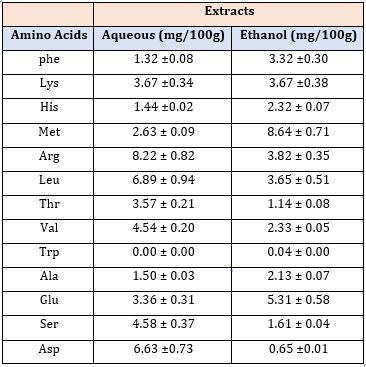Analyses of Metal and Amino Acid Compositions of Aqueous and Ethanol Stem Bark Extracts of Dialium Guineense by Abu OD in Open Access Journal of BiogenericScience and Research
Abstract
Background: The use of medicinal plants in alternative medicine has received huge attention in recent times. Dialium guineense belongs to the Leguminosae family, and grows in dense forests in Africa along the southern edge of the Sahel. The bark, leaves and fruits of the plant have medicinal properties and are used to treat diseases such as stomatitis, toothache, fever, diarrhea, palpitations, and microbial infections. The present study evaluated the metal and amino acid composition of aqueous and ethanol extracts of Dialium guineense stem bark.
Materials and Methods: The stem bark of the plant was extracted using distilled water and absolute ethanol according to standard method, and subjected to high performance liquid chromatography (HPLC).
Results: The results of metal analysis revealed the presence of selenium manganese, zinc, chromium, vanadium and calcium in appreciable amounts. Essential and non-essential amino acids such as phenylalanine, lysine, histidine, methionine, arginine, leucine, threonine, valine, tryptophan, alanine, glutamate, serine, and aspartate were also detected.
Conclusion: These results suggest that aqueous and ethanol stem bark extracts of D. guineense is a rich source (reservoir) of amino acids, macro- and micro nutrients.
Keywords: Amino acids, Dialium guineense, Extract, Metals, Stem bark
Introduction
Medicinal plants are re-emerging health aids which have gained huge attention in recent times [1]. Dialium guineense (Velvet Tamarind), is a tall, tropical, fruit-bearing tree. It belongs to the Leguminosae family, and grows in dense forests in Africa along the southern edge of the Sahel. The bark, leaves and fruits of the plant have medicinal properties and are used to treat diseases such as stomatitis, toothache, fever, diarrhea, palpitations, and microbial infections1. Trace elements such as chromium, selenium, vanadium and zinc are required for the maintenance of normal glucose uptake and metabolism and enhancement of insulin sensitivity [2-4]. The aim of this study was to evaluate the metal and amino acid compositions of aqueous and ethanol stem bark extracts of Dialium guineense.
Materials and Methods
The plant leaves were obtained from a forest area in Benin and identified at the Department of Plant Biology and Biotechnology with voucher number UBHD330, after which the bark was obtained. Preparation and extraction was carried out using standard method [5]. The aqueous and ethanol extracts were concentrated using rotary evaporator and made into powder by lyophilisation.
1.1. Study Design
Elemental analysis of the extracts was determined using Atomic Absorption Spectrometry [6], while amino acid analysis was performed using High Performance Liquid Chromatography [6].
1.2. Study Location
The present study was carried out at the Department of Biochemistry, Faculty of Life Sciences, University of Benin, Benin City, Nigeria.
1.3. Study Duration
July 2019 to December 2019.
1.4. Statistical analysis
Data are expressed as mean ± SEM. Statistical analysis was performed with SPSS (16.0).
Values of p < 0.05 were considered statistically significant.
Results
2.1. Elemental composition
The aqueous extract had higher amounts of selenium and manganese than the ethanol extract, while the ethanol extract had higher amounts of zinc, chromiun, vanadium and calcium than the aqueous extract. Although there were no significant differences between them (Table 1).
2.2. Amino acid composition
Both extracts had high concentrations of methionine and arginine, but there was no trace of tryptophan in the aqueous extract (Table 2)
Table 1: Elemental analysis of aqueous and ethanol stem bark extracts of Dialium guineense.


Discussion
The bark, leaves and fruits of Dialium guineense have medicinal properties and are used to treat diseases such as stomatitis, toothache, fever, diarrhea, palpitations, and microbial infections [7]. Trace elements play crucial roles in carbohydrate, lipid and protein metabolism. Selenium inhibits hyperglycaemia or hyperinsulinaemia-induced expression of adhesion molecules. It also reduces inflammation, C-reactive proteins and soluble L-selectin. Trivalent chromium (Cr3+) is required for the maintenance of normal glucose metabolism. Its deficiency leads to impaired glucose tolerance [2]. Vanadium has been shown to facilitate glucose uptake and metabolism, lipid and amino acid metabolism, improve thyroid function, enhance insulin sensitivity, and negatively affect bone and tooth development in high doses3,4. As dietary protein is digested and absorbed by the gut, dietary amino acids (AAs) are extracted by the splanchnic area (i.e., portal drained viscera and liver) during their first pass or alternatively released into the systemic circulation. The extent of their extraction reflects on their availability in the systemic circulation. Likely, it is the increase in the concentrations of extracellular AAs after a meal that gives signal for protein synthesis [8] and consequently AAs are transported into the muscle. However, a fall in extracellular AA concentrations below basal levels inhibits the stimulation of muscle protein synthesis [9]. There are two factors that play a key role in modifying the capacity for protein anabolism during feeding in situations where a chronic or acute disease is present: first-pass splanchnic extraction (SPE) of dietary AAs and anabolic resistance to dietary AAs.
Conclusion
The results of this study have shown that aqueous and ethanol stem bark extracts of Dialium guineense are rich sources of trace elements and essential amino acids.
Funding
This work was supported with grants from the URPC, University of Benin, Benin City.
More information regarding this Article visit: OAJBGSR
https://biogenericpublishers.com/pdf/JBGSR.MS.ID.00154.pdf
https://biogenericpublishers.com/jbgsr.ms.id.00154.text/
For more open access journals click on https://biogenericpublishers.com/

No comments:
Post a Comment